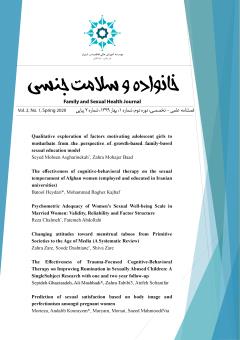-
-
-
Open Access Article
1 - Psychometric Adequacy of Persian Version of Women Sexual Schema
Jhale Refahi Nasir Dastan maryam behnam -
Open Access Article
2 - Psychometric Adequacy of Persian Version of Women Sexual Schema
ژاله رفاهی -
Open Access Article
3 - Sexual schemas and psychological well-being in married women: Investigating the mediating role of sexual function
Reza Chalme Fateme Abdollahi -
Open Access Article
4 - Psychometric Adequacy of Women's Sexual Well-being Scale in Married Women: Validity, Reliability and Factor Structure
reza chalmeh fatemeh abdolahi -
Open Access Article
5 - Changing attitudes toward menstrual taboos from Primitive Societies to the Age of Media (A Systematic Review)
Zahra Zare soode dashtiane shiva zare -
Open Access Article
6 - Prediction of sexual satisfaction based on body image and perfectionism amongst pregnant women
morteza Andalib Kourayem maryam morsali saeed mahmoodinia -
Open Access Article
7 - Psychological consequences of violence against women and girls
Kazem Khorramdel Zahra Zare
List of Articles Women
-
The rights to this website are owned by the Raimag Press Management System.
Copyright © 2017-2025


